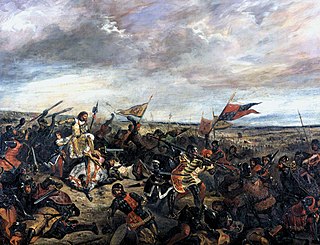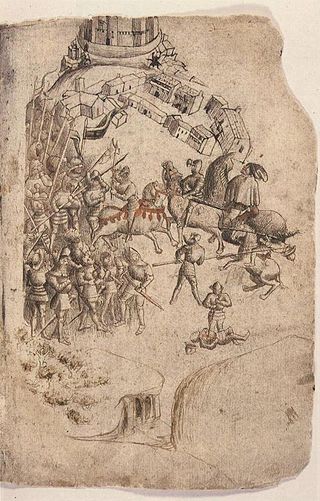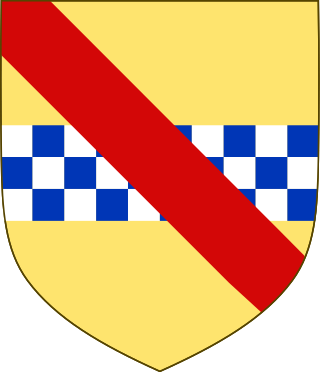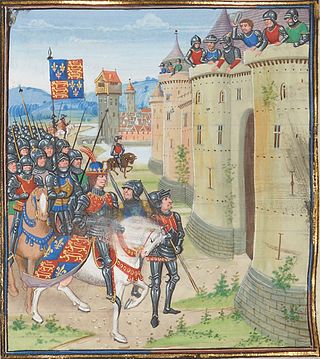
The Battle of Poitiers was fought on 19 September 1356 between a French army commanded by King John II and an Anglo-Gascon force under Edward, the Black Prince, during the Hundred Years' War. It took place in western France, 5 miles (8 km) south of Poitiers, when approximately 14,000 to 16,000 French attacked a strong defensive position held by 6,000 Anglo-Gascons.

The English longbow was a powerful medieval type of bow, about 6 ft (1.8 m) long. While it is debated whether it originated in England or in Wales from the Welsh bow, by the 14th century the longbow was being used by both the English and the Welsh as a weapon of war and for hunting. English longbows were effective against the French during the Hundred Years' War, particularly in the battles of Sluys (1340), Crécy (1346), Poitiers (1356), and the Battle of Agincourt (1415). They were less successful later on, as longbowmen had their lines broken at the Battle of Verneuil (1424); although the English won a decisive victory there, they were completely routed at the Battle of Patay (1429) when they were charged by the French mounted men-at-arms before they had prepared the terrain and finished defensive arrangements. The Battle of Pontvallain (1370) had also previously shown longbowmen were not particularly effective when not given the time to set up defensive positions.

The Wars of Scottish Independence were a series of military campaigns fought between the Kingdom of Scotland and the Kingdom of England in the late 13th and early 14th centuries.

The Battle of Bannockburn was fought on 23–24 June 1314, between the army of Robert the Bruce, King of Scots, and the army of King Edward II of England, during the First War of Scottish Independence. It was a decisive victory for Robert Bruce and formed a major turning point in the war, which ended 14 years later with the de jure restoration of Scottish independence under the Treaty of Edinburgh–Northampton. For this reason, the Battle of Bannockburn is widely considered a landmark moment in Scottish history.

The Battle of Crécy took place on 26 August 1346 in northern France between a French army commanded by King Philip VI and an English army led by King Edward III. The French attacked the English while they were traversing northern France during the Hundred Years' War, resulting in an English victory and heavy loss of life among the French.

Yeoman is a noun originally referring either to one who owns and cultivates land or to the middle ranks of servants in an English royal or noble household. The term was first documented in mid-14th-century England. The 14th century also witnessed the rise of the yeoman longbow archer during the Hundred Years' War, and the yeoman outlaws celebrated in the Robin Hood ballads. Yeomen also joined the English Navy during the Hundred Years' War as seamen and archers. In the early 15th century, yeoman was the rank of chivalry between page and squire. By the late 17th century, yeoman became a rank in the Royal Navy for the common seamen who were in charge of ship's stores, such as foodstuffs, gunpowder, and sails.
The Battle of Halidon Hill took place on 19 July 1333 when a Scottish army under Sir Archibald Douglas attacked an English army commanded by King Edward III of England and was heavily defeated. The year before, Edward Balliol had seized the Scottish Crown from five-year-old David II, surreptitiously supported by Edward III. This marked the start of the Second War of Scottish Independence. Balliol was shortly expelled from Scotland by a popular uprising, which Edward III used as a casus belli, invading Scotland in 1333. The immediate target was the strategically-important border town of Berwick-upon-Tweed, which the English besieged in March.
The Battle of Dupplin Moor was fought between supporters of King David II of Scotland, the son of King Robert Bruce, and English-backed invaders supporting Edward Balliol, son of King John I of Scotland, on 11 August 1332. It took place a little to the south west of Perth, Scotland, when a Scottish force commanded by Donald, Earl of Mar, estimated to have been stronger than 15,000 and possibly as many as 40,000 men, attacked a largely English force of 1,500 commanded by Balliol and Henry Beaumont, Earl of Buchan. This was the first major battle of the Second War of Scottish Independence.
The Battle of Falkirk, on 22 July 1298, was one of the major battles in the First War of Scottish Independence. Led by King Edward I of England, the English army defeated the Scots, led by William Wallace. Shortly after the battle Wallace resigned as Guardian of Scotland.

The Battle of Neville's Cross took place during the Second War of Scottish Independence on 17 October 1346, half a mile to the west of Durham, England. An invading Scottish army of 12,000 led by King David II was defeated with heavy loss by an English army of approximately 6,000–7,000 men led by Ralph Neville, Lord Neville. The battle was named after an Anglo-Saxon stone cross that stood on the hill where the Scots made their stand. After the victory, Neville paid to have a new cross erected to commemorate the day.
The Battle of Saint-Pol-de-Léon was a minor action during the Breton War of Succession and thus part of the larger Hundred Years War. The battle was fought in June 1346 and marked a minor turning point in the fortunes of the Montfortists and their English allies in Brittany following several setbacks including the imprisonment and subsequent death of their leader, John of Montfort.

Henry de Beaumont, jure uxoris 4th Earl of Buchan and suo jure 1st Baron Beaumont, was a key figure in the Anglo-Scots wars of the thirteenth and fourteenth centuries, known as the Wars of Scottish Independence.
The Battle of Boroughmuir was fought on 30 July 1335 between Guy, Count of Namur, a cousin of Queen Philippa of England, and John Randolph, 3rd Earl of Moray and Guardian of Scotland. Namur was on his way to join Edward III on his invasion of Scotland, when he was intercepted on the common grazing ground to the south of Edinburgh – the Borough Muir. The fighting continued into the city itself, and concluded in a desperate struggle in the ruins of the old castle. Randolph was victorious in a fight which forms a small part of the Second War of Scottish Independence.
Sir Archibald Douglas was a Scottish nobleman, Guardian of Scotland, and military leader. He is sometimes given the epithet "Tyneman", but this may be a reference to his great-nephew Archibald Douglas, 4th Earl of Douglas. He fought and died at the Battle of Halidon Hill.
The Second War of Scottish Independence broke out in 1332 when Edward Balliol led an English-backed invasion of Scotland. Balliol, the son of former Scottish king John Balliol, was attempting to make good his claim to the Scottish throne. He was opposed by Scots loyal to the occupant of the throne, eight-year-old David II. At the Battle of Dupplin Moor Balliol's force defeated a Scottish army ten times their size and Balliol was crowned king. Within three months David's partisans had regrouped and forced Balliol out of Scotland. He appealed to the English king, Edward III, who invaded Scotland in 1333 and besieged the important trading town of Berwick. A large Scottish army attempted to relieve it but was heavily defeated at the Battle of Halidon Hill. Balliol established his authority over most of Scotland, ceded to England the eight counties of south-east Scotland and did homage to Edward for the rest of the country as a fief.

Sir John Stewart, the brother of Sir James the 5th High Steward of Scotland, was a Scottish knight and military commander during the First Scottish War of Independence.
Sir Willian Felton and English knight and seneschal of Poitou. Took part in Battle of Halidon Hill, 1333 and fought at Crecy in 1346. He was appointed lord justice of all the king's lands in Scotland in 1348. He fought at battle of Poitiers in 1356. He was appointed seneschal of Poitou in 1360. He accompanied the Black Prince on the Spanish campaign in 1367 and was called Felleton Guilliam qui ot cœur de lyon by Chandos Herald. He was killed at the battle of Aríñez a skirmish fought by the vanguard of the Black Prince's army.

The siege of Berwick lasted four months in 1333 and resulted in the Scottish-held town of Berwick-upon-Tweed being captured by an English army commanded by King Edward III. The year before, Edward Balliol had seized the Scottish Crown, surreptitiously supported by Edward III. He was shortly thereafter expelled from the kingdom by a popular uprising. Edward III used this as a casus belli and invaded Scotland. The immediate target was the strategically important border town of Berwick.
Burnt Candlemas was a failed invasion of Scotland in early 1356 by an English army commanded by King Edward III, and was the last campaign of the Second War of Scottish Independence. Tensions on the Anglo-Scottish border led to a military build-up by both sides in 1355. In September a nine-month truce was agreed, and most of the English forces left for northern France to take part in a campaign of the concurrent Hundred Years' War. A few days after agreeing the truce, the Scots, encouraged and subsidised by the French, broke it, invading and devastating Northumberland. In late December the Scots escaladed and captured the important English-held border town of Berwick-on-Tweed and laid siege to its castle. The English army redeployed from France to Newcastle in northern England.










